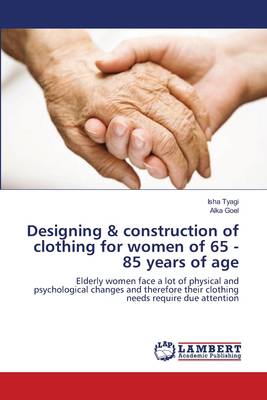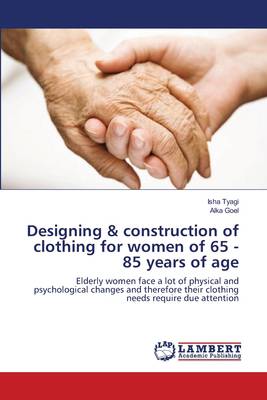
- Afhalen na 1 uur in een winkel met voorraad
- Gratis thuislevering in België vanaf € 30
- Ruim aanbod met 7 miljoen producten
- Afhalen na 1 uur in een winkel met voorraad
- Gratis thuislevering in België vanaf € 30
- Ruim aanbod met 7 miljoen producten
Zoeken
Designing & construction of clothing for women of 65 - 85 years of age
Elderly women face a lot of physical and psychological changes and therefore their clothing needs require due attention
Isha Tyagi, Alka Goel
Paperback | Engels
€ 67,45
+ 134 punten
Omschrijving
Population figures and forecasts suggest that the youth market is shrinking. Therefore adults aged over 60, the so-called grey market , have been the focus of several pieces of research. As the vigorous older population becomes more influential at the polls and in the market-place, we are continuously witnessing changes in government programs, housing, new products and media attention. The World Health Organization (WHO) is promoting a broad approach to aging that goes beyond the prevention and treatment of disease. WHO's "active aging" policies seek to extend healthy life expectancy, increase productivity and improve the quality of life among older people. But no systematic work has been done regarding the clothing preferences of elderly which indirectly boost their social and psychological life. Clothing preferences and problems of this age group have not received the consideration and study given to other age levels. Clothing designed especially for the elderly is non-existent inspite of the fact that every day a large number of men and women pass their sixty-fifth birthday and move into the great fraternity of the young olds.
Specificaties
Betrokkenen
- Auteur(s):
- Uitgeverij:
Inhoud
- Aantal bladzijden:
- 168
- Taal:
- Engels
Eigenschappen
- Productcode (EAN):
- 9783659198830
- Verschijningsdatum:
- 21/08/2012
- Uitvoering:
- Paperback
- Afmetingen:
- 152 mm x 229 mm
- Gewicht:
- 254 g

Alleen bij Standaard Boekhandel
+ 134 punten op je klantenkaart van Standaard Boekhandel
Beoordelingen
We publiceren alleen reviews die voldoen aan de voorwaarden voor reviews. Bekijk onze voorwaarden voor reviews.











